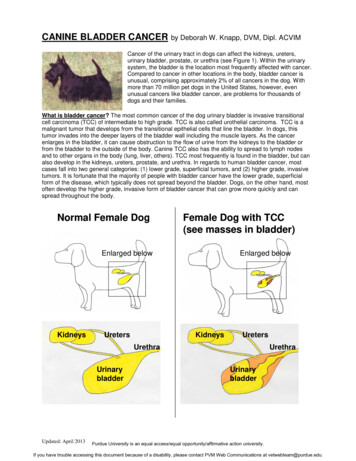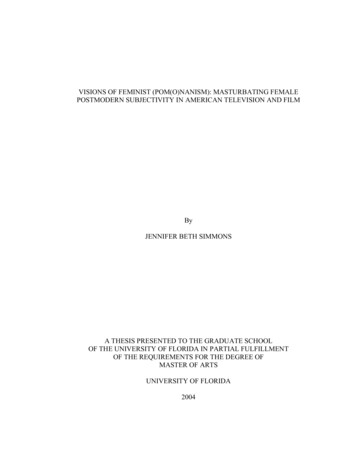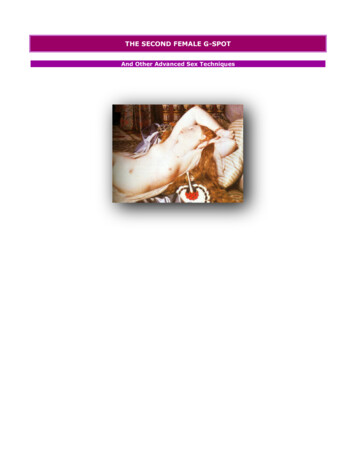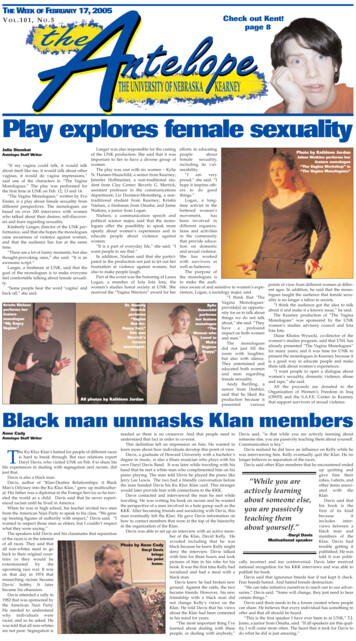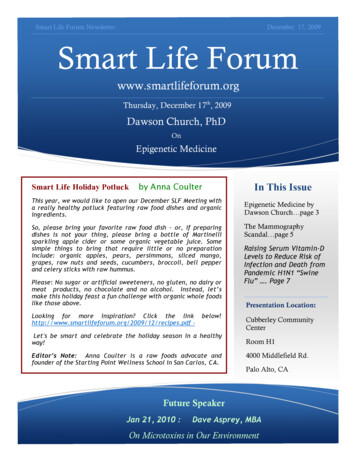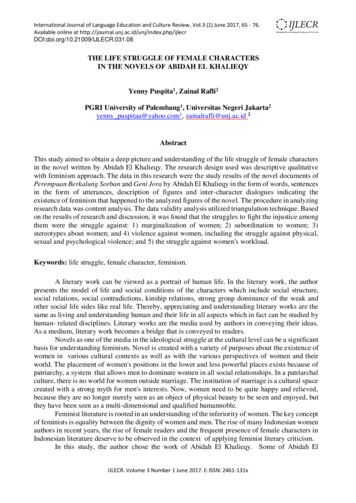
Transcription
International Journal of Language Education and Culture Review, Vol.3 (1) June 2017, 65 - 76.Available online at oi.org/10.21009/IJLECR.031.08THE LIFE STRUGGLE OF FEMALE CHARACTERSIN THE NOVELS OF ABIDAH EL KHALIEQYYenny Puspita1 , Zainal Rafli 2PGRI University of Palembang 1, Universitas Negeri Jakarta2yenny puspitaa@yahoo.com1, zainalrafli@unj.ac.id 2AbstractThis study aimed to obtain a deep picture and understanding of the life struggle of female charactersin the novel written by Abidah El Khalieqy. The research design used was descriptive qualitativewith feminism approach. The data in this research were the study results of the novel documents ofPerempuan Berkalung Sorban and Geni Jora by Abidah El Khalieqy in the form of words, sentencesin the form of utterances, description of figures and inter-character dialogues indicating theexistence of feminism that happened to the analyzed figures of the novel. The procedure in analyzingresearch data was content analysis. The data validity analysis utilized triangulation technique. Basedon the results of research and discussion, it was found that the struggles to fight the injustice amongthem were the struggle against: 1) marginalization of women; 2) subordination to women; 3)stereotypes about women; and 4) violence against women, including the struggle against physical,sexual and psychological violence; and 5) the struggle against women's workload.Keywords: life struggle, female character, feminism.A literary work can be viewed as a portrait of human life. In the literary work, the authorpresents the model of life and social conditions of the characters which include social structure,social relations, social contradictions, kinship relations, strong group dominance of the weak andother social life sides like real life. Thereby, appreciating and understanding literary works are thesame as living and understanding human and their life in all aspects which in fact can be studied byhuman- related disciplines. Literary works are the media used by authors in conveying their ideas.As a medium, literary work becomes a bridge that is conveyed to readers.Novels as one of the media in the ideological struggle at the cultural level can be a significantbasis for understanding feminism. Novel is created with a variety of purposes about the existence ofwomen in various cultural contexts as well as with the various perspectives of women and theirworld. The placement of women's positions in the lower and less powerful places exists because ofpatriarchy, a system that allows men to dominate women in all social relationships. In a patriarchalculture, there is no world for women outside marriage. The institution of marriage is a cultural spacecreated with a strong myth for men's interests. Now, women need to be quite happy and relieved,because they are no longer merely seen as an object of physical beauty to be seen and enjoyed, butthey have been seen as a multi-dimensional and qualified humannoble.Feminist literature is rooted in an understanding of the inferiority of women. The key conceptof feminists is equality between the dignity of women and men. The rise of many Indonesian womenauthors in recent years, the rise of female readers and the frequent presence of female characters inIndonesian literature deserve to be observed in the context of applying feminist literary criticism.In this study, the author chose the work of Abidah El Khalieqy. Some of Abidah ElIJLECR. Volume 3 Number 1 June 2017. E-ISSN: 2461-131x
International Journal of Language Education and Culture Review, Vol. 3 (1), June 2017Khalieqy's works are best seller. The results of her writings had gained national recognition,especially for the category of female authors. In her works, Abidah more dominantly raisedfeminist issues with the background of boarding school life. This research focused on the novel textwhich were limited to the feminism problem in the novels Perempuan Berkalung Sorban (2001) andGeni Jora (2004) written by Abidah El Khalieqy. Both novels featured attractive, complex anddynamic female characters that deserved to be investigated.The selection of the Perempuan Berkalung Sorban and Geni Jora novels by Abidah el Khaileqy asthe object of research was based on actual and relevant issues with contemporary life that would beuseful for organizing a better future, especially for women. In addition, the novel PerempuanBerkalung Sorban and Geni Jora by Abidah el Khaileqy could be used as teaching material as amodel of gender-based literary learning. This study examined several issues related to women's viewof life, forms of injustice against women and the struggle of women leaders. This study aimed to seethe position of women in the middle of patriarchal cultural system that existed in the novel based onfeminism perspective. This research was conducted to get a deeper description and understandingabout the life struggle of female characters in the novels of Abidah El Khalieqy.Feminism was born in the early 20th century pioneered by Virginia Woolf (2013) that feminism isderived from the word femine (woman) meaning a woman (singular) which aims to fight for therights of women (plural) as a social class. Furthermore, Thornham (2000: 38) considered women tobe inside and outside all the symbolic structures that make up identity. Women are out of the nationbecause they themselves can not claim a national identity. They are outside the class because theydo not have a class marker. In the material sense, women are confined in the private sphere excludedfrom social power, but their ideological power is much greater.Gender differences will not be a problem as long as it does not give rise to genderinequalities. However, gender differences have generated gender inequality, especially to women.Manifestations of gender inequality occur in various forms in the economic, political, social andculture (Fakih, 2003: 12). On the other hand, Sugihastuti and Suharto (2010: 18) said that feminismis a movement of equality between men and women in all fields, political, economic, educationalsocial or organized activities that defend women's rights and interests. Feminism is an awareness ofoppression and extortion of women in society both in the workplace and at home.Sugihastuti and Suharto (2010: 18) say that feminism is a movement of equality betweenmen and women in all fields, political, economic, educational, social or organized activities thatdefend women's rights and interests. In the development, injustice happen to women merged in theliterary work because the dominance of patriarchal culture is the production and acceptance ofliterary works in the hands of men. Most literary works are written and also criticized by men(Hellwig, 2003: 10-11). In a literary world full of imaginary, characters of male characters areportrayed as someone who possesses heroic traits and of course, the depictions of women fit theirimaginations as well. A female hero can be a heroine if it is in accordance with the concepts thatmen have determined.Critics of feminist literature have an important goal of feminist literary criticism, which is tohelp the reader understand, describe, interpret and judge the works written by authors (Djajanegara,2000: 27). Thus, feminist discourses have changed the approaches to all literature, and that theintegration of women's voices has developed. Although it seems that up to now feminist literarycriticism has not made as much change as needed yet. The subsequent development is feministliterary critics also paid attention to women as writers.Feminism StudyTo date, various juridical activities and instruments have been established to support therealization of Gender Equality and Justice (Kesetaraan dan Keadilan Gender) in Indonesia. The66
International Journal of Language Education and Culture Review, Vol. 3 (1), June 2017government's commitment through the Ministry of Women's Empowerment to bring gender equalityand justice into reality is very high. The Government of Indonesia ratified by law No. 23 of 2004 onthe Elimination of Domestic Violence (PKDRT) which provides protection for victims of violenceand criminal sanctions for the perpetrators. The development of women's studies related to theparadigm underlying the struggle or demand for gender concerns in Indonesia is outlined below: (1)the concept of Women in Development (WID), (2) the Gender and Development Concept, (3) theConcept of Gender Women Empowerment (PUG ) Or Gender Mainstreaming (Cleves, 2007: 21-30).In Nugroho's view (2008: 40), gender inequality is a system and structure for men and womento be victims of the system. This view illustrates that gender is one of the key social structures ofcontemporary culture and is characterized by power struggles and injustices. Gender and inequalityhierarchies are maintained among other factors, with meaning and belief systems, and this altersresults through representation. Representation is built through language, image, social practice,material and symbol dimensions. Still on the similar perception, Sugihastuti (2000: 113-121) givesan overview of the role of women in everyday life, whether at home or outside, every woman hasher own choice and is responsible for her own desires. The role of the female character is part of themain task that must be performed as a woman. There are various roles that she has from birth toadulthood, such as being a wife, as a mother, and as a parent. The roles that she possessed are partof her life as a woman.Women's StruggleGender studies related to the concept of women's empowerment promote gender equalityand empower women as an effective way to combat poverty, hunger and disease. This was done tomeet the practical and strategic needs of women. The fulfillment of women's practical needs involvesthe need for women to carry out social roles to meet short-termneeds such as improving living standards, improving health services, providing employment,illiteracy eradication and so forth.1. Marginalization of WomenAccording to Muniarti (2004: 20), marginalization is placing or shifting women to theperiphery. Women are imaged weak, lacking or irrational, lacking or daring, so inappropriate orunfit to lead. As a result, women are always secondary whenever there is a chance to lead. What ismeant by marginalization is the process of impoverishing women so that women cannot act andexpress because the role of women is shifted to the margins or marginalization of women positionssocially in the acquisition of economic and political resources both in the domestic and publicsphere.2. Subordination toward WomenSunarto (2009: 139) states that subordination is an effect arising from the dominant positionof men over women acquired through physical violence, coercion, structural violence (done bysocial institutions and economic power), and symbolic violence. Thus, subordination is defined asa social process in the life of a society that raises a policy on women so that it does not consider thatwomen are important which position women and their work lower than men.3. Gender and StereotypeStereotypes are the labeling or marking of a particular group. A stereotypical view is astandard image of an individual or group that is inconsistent with existing empirical reality. Negativelabeling (stereotypes) generally generates gender inequality. Gender-role stereotypes are commoncategories that describe views and beliefs about women and men (Santrock, 2003: 374). Thus,stereotyping is the labeling or negative labeling of a people with all forms of representation of thebeliefs of society.4. Gender and ViolenceMany kinds and forms of crimes can be categorized as gender violence, including: the form67
International Journal of Language Education and Culture Review, Vol. 3 (1), June 2017of female rape, including rape in marriage;Acts of beatings and domestic violence; Forms of genital mutilation; Violence in prostitution;Violence in pornography; Violence in KB settlement; Veiled violence; Sexual violence (Fakih,2003: 20). Violence against women is an attack carried out because of the gender assumption thatmakes women as victims of domestic violence, whether physical, psychic, economic neglect, andsexual violence5. WorkloadNugroho (2008: 47) argues that women's gender roles in the public's assumption is managingthe households so that many women bear the domestic workload more and longer than men. In fact,for the poor families, the burden must be borne by women in addition to working outside so thatthey should bear a double workload. For community groups with sufficient economic levels,domestic workloads are often assigned tohousemaidsMETHODThis research used descriptive qualitative design. The researchers described systematically,factually, and accurately about the studied facts and causal relationships of the phenomena. Dataobtained in this study were through explanation, speech figures or attitude, or the thought thatAbidah El Khalieqy would like to convey through his novels.The study relied on inter subjectivity assumptions and generally created the meaning and"reality" between researchers and participants.The data in this research were the result of study of novel document of PerempuanBerkalung Sorban and Geni Jora by Abidah El Khalieqy in the form of words, sentences in the formof utterances, description of figures, and inter-character dialogue which indicated the existence offeminism that happened to the analyzed novel figures. The data analysis procedure used in thisresearch was content analysis. Content analysis also analyzed not only the manifest nature of a textas Mayring (2000) says: "Content analys is not only the manifest content of the material-as its namesuggests". When referring to Mayring, content analysis also emphasizes on the data interpretation.Data validity analysis used triangulation technique. There are two forms of triangulation tocheck data in theoretica
THE LIFE STRUGGLE OF FEMALE CHARACTERS IN THE NOVELS OF ABIDAH EL KHALIEQY Yenny Puspita1, . Violence against women is an attack carried out because of the gender assumption that makes women as victims of domestic violence, whether physical, psychic, economic neglect, and . International Journal of Language Education and Culture Review, Vol. 3 (1), June 2017 . International
